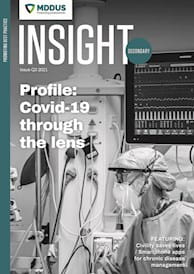BACKGROUND
Mr G is 71 years old and attends hospital for a hernia repair. In the anaesthetic room, Dr B, a trust doctor in anaesthetics, proceeds to insert a cannula.
Mr G has small veins and Dr B makes four attempts at inserting the cannula before employing a smaller bore cannula. Mr G has become increasingly distressed and by the fifth attempt demands that someone more senior take over the procedure. However, Dr B is now confident the cannula is inside the lumen of the vein and confirms by injecting 10 ml of saline solution.
Mr G complains of a mild tingling sensation on injection and expresses his doubt the cannula is correctly placed. Dr B reassures him the cannula is now correctly placed and proceeds with the anaesthetic.
The anaesthetic takes effect and the hernia repair is performed with no further complications.
A week later the hospital trust receives a letter of complaint from Mr G. He states that he is “astonished” that an experienced doctor should make five attempts at inserting a cannula without asking for assistance from someone more senior.
Mr G also questions why on awaking from the procedure he found the cannula had been re-sited to the opposite left hand. This has made him wonder whether the cannula had not been adequately sited even on the fifth attempt. He reports that his right hand is now severely swollen and bruised.
Dr B is contacted by the hospital complaints and improvements team and asked to provide an account of the care provided to Mr G. She emails MDDUS asking for a review of her response letter. A medical adviser responds with comments and suggestions, which Dr B then incorporates into her letter.
ANALYSIS/OUTCOME
In the letter Dr B first expresses her regret for the distress Mr G experienced during the procedure. She details the difficulties encountered in finding a suitable vein in which to site the cannula and acknowledges the discomfort Mr G experienced in the numerous attempts.
Dr B points out that even senior anaesthetists can experience difficulty in inserting cannulas in some patients. She states that normally she would have asked for assistance but the unit was very busy that morning and she did not want to cause unnecessary delay to Mr G’s procedure.
Dr B further states that the cannula was, in her view, adequately sited on the fifth attempt given that the anaesthetic took effect. She explains that in some surgical procedures it is common practice to insert a larger bore cannula (for increased flow) once the patient is asleep as anaesthetic medication tends to dilate the veins and allow for easier insertion. This is why Mr G found the cannula re-sited to his left hand. Starting an infusion via a small cannula and vein can increase tingling and discomfort, as experienced by Mr G.
Swelling and bruising are unfortunate side effects of cannula insertion and Dr B again apologises at the extent endured by Mr G. She states that the incident has led her to reflect with her appraiser on the care provided to Mr G and in future to not feel rushed and to ask for assistance if needed no matter how much this may delay a procedure.
Mr G makes no further contact with the hospital and the complaint is closed.
KEY POINTS
- Doctors are expected to be open and honest with patients when something goes wrong.
- A clear explanation of why something went wrong and how it might be prevented in future may be all that a complainant is looking for.
- Ensure you comply with your hospital or trust complaint procedures.
This page was correct at the time of publication. Any guidance is intended as general guidance for members only. If you are a member and need specific advice relating to your own circumstances, please contact one of our advisers.
Read more from this issue of Insight Secondary

Save this article
Save this article to a list of favourite articles which members can access in their account.
Save to library

